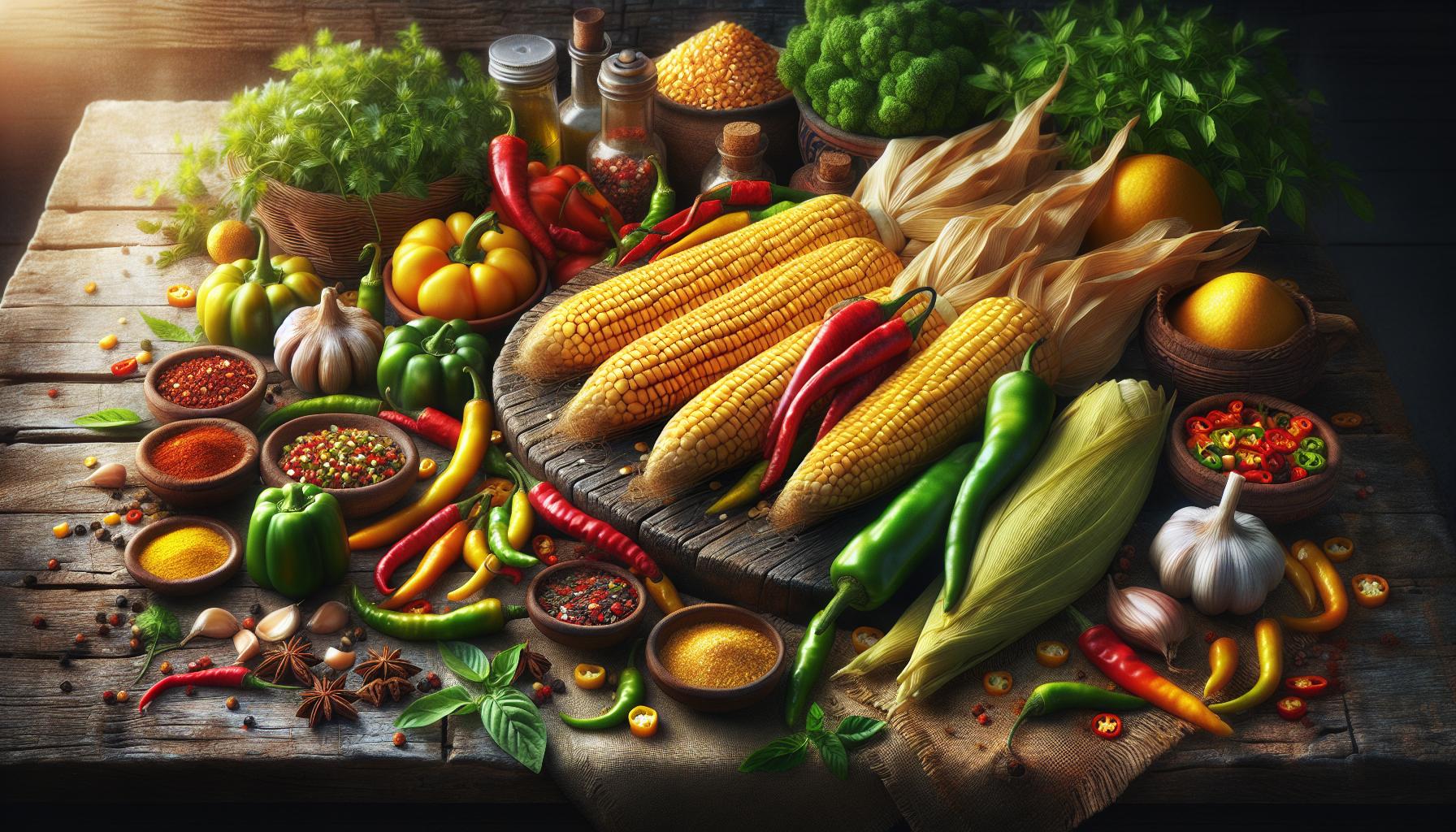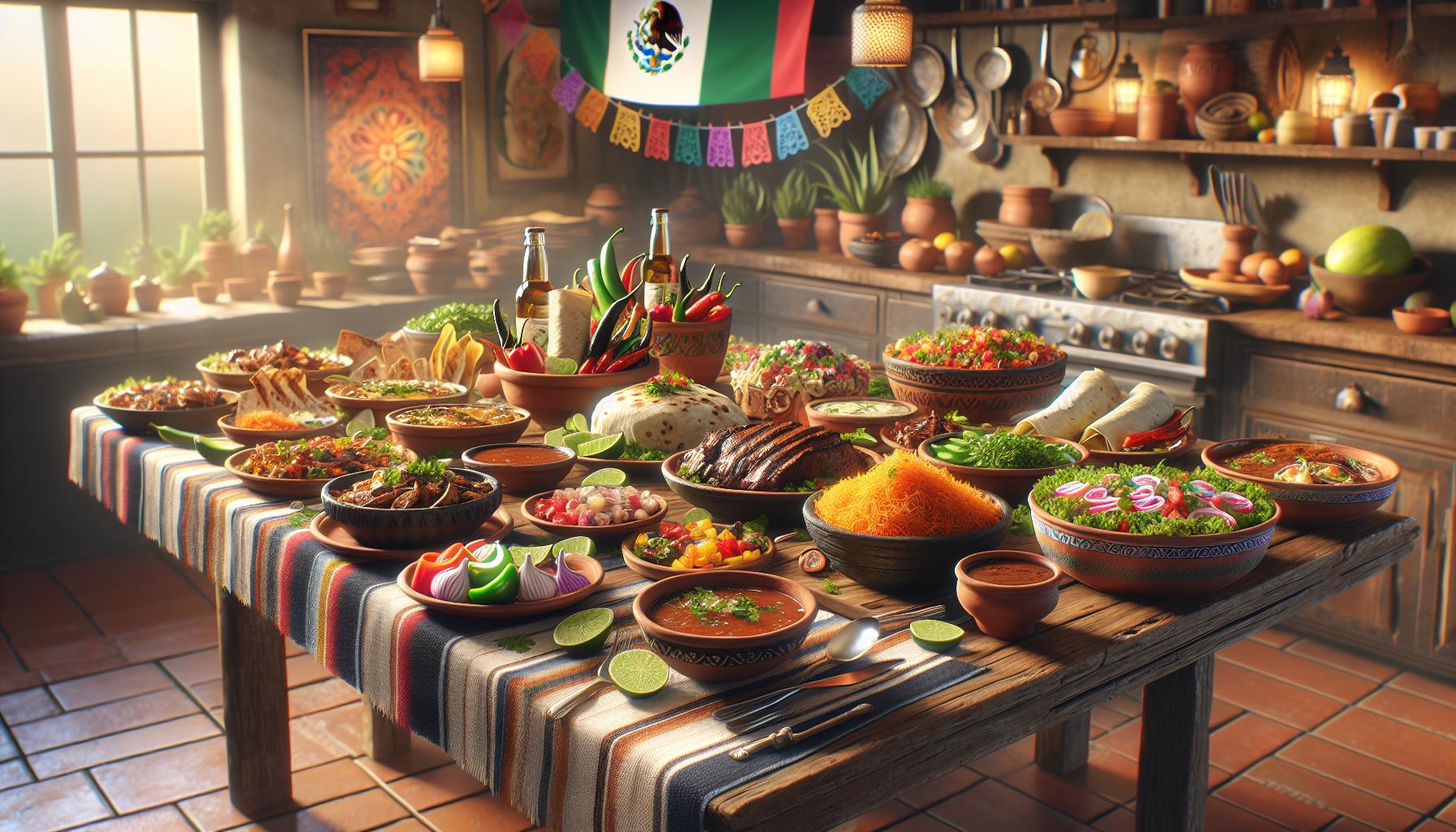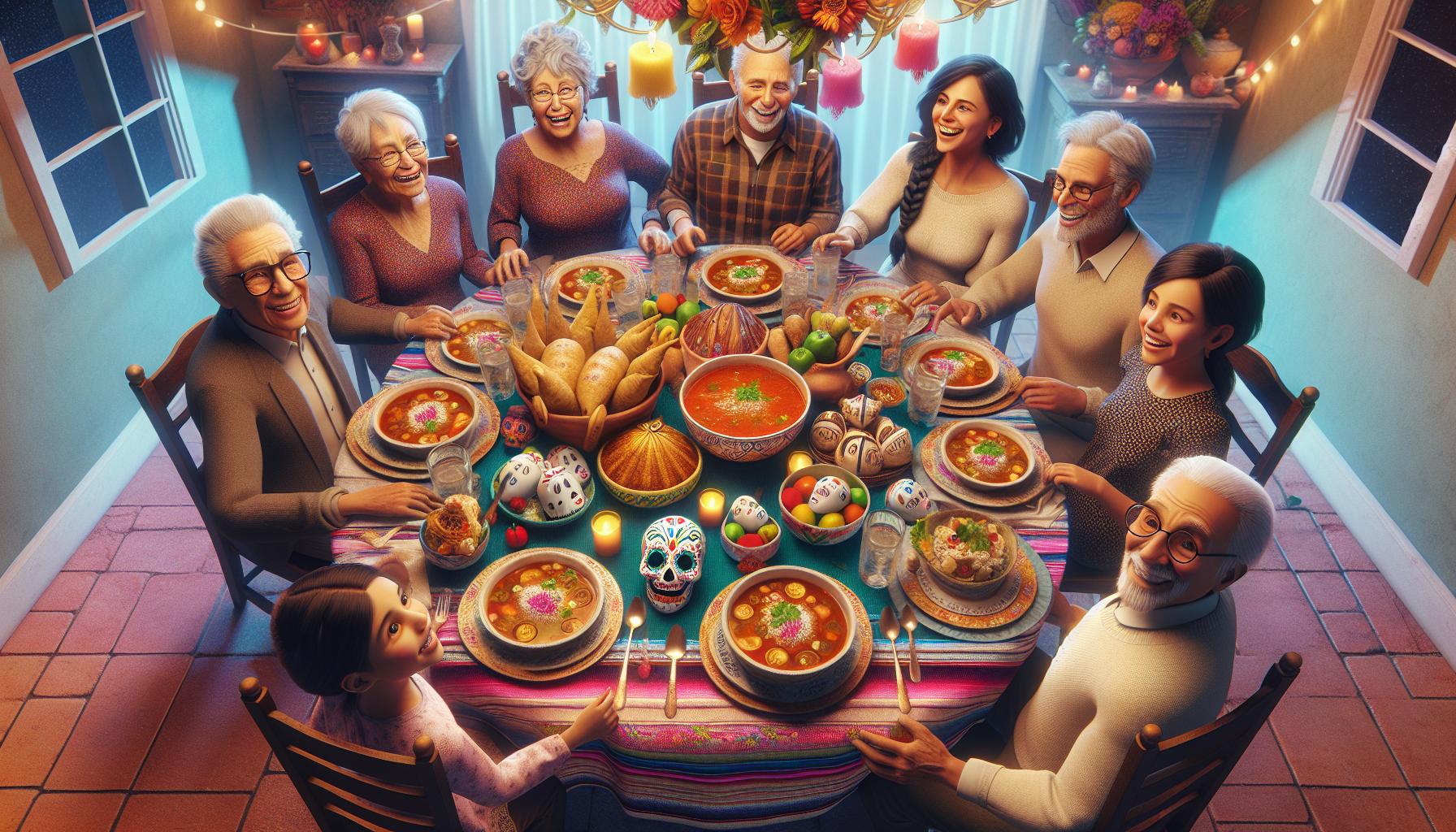Mexican cuisine stands as one of the world’s most vibrant and diverse culinary traditions. From the sizzling street tacos to complex mole sauces passed down through generations, traditional Mexican food culture tells a story of heritage, family, and centuries-old techniques that have shaped the nation’s identity.
At its heart, Mexican food culture isn’t just about eating – it’s a celebration of life itself. Each region boasts its unique flavors and specialties crafted from indigenous ingredients that have been used since pre-Hispanic times. Whether it’s the coastal seafood dishes of Veracruz or the rich, smoky flavors of Oaxaca’s seven moles, there’s a world of taste waiting to be explored beyond the familiar chips and salsa most people know.
Traditional Mexican Food Culture
Mexican cuisine emerged from a complex tapestry of cultural influences spanning thousands of years. The interplay between indigenous traditions and colonial elements created a distinctive culinary heritage that continues to evolve.
Pre-Hispanic Origins
Ancient Mesoamerican civilizations established the cornerstone of Mexican cuisine through sophisticated agricultural practices. The Aztecs cultivated essential ingredients like corn, beans, chilies, tomatoes, squash, cacao, vanilla, agave. Their sophisticated chinampas (floating gardens) produced abundant crops year-round. The Mayans contributed farming techniques for growing tropical fruits, raising turkeys, and harvesting honey. These civilizations developed cooking methods still used today, including nixtamalization of corn, underground pit cooking, and stone grinding on metates. Sacred foods like amaranth and chia held both nutritional and ceremonial significance in pre-Hispanic rituals.
Spanish Colonial Influence
Spanish conquistadors introduced new ingredients that transformed indigenous Mexican cooking in the 16th century. Dairy products, pork, chicken, beef, sheep, goats, wheat, rice, olive oil, wine, garlic, onions arrived with European settlers. The Spanish brought citrus fruits, sugar cane, spices from their Asian colonies. Indigenous cooks incorporated these new elements into existing recipes, creating distinctive fusion dishes. Convents became culinary innovation centers, developing recipes like chiles en nogada, mole poblano. The combination of pre-Hispanic cooking techniques with European ingredients gave birth to iconic Mexican dishes like tamales with pork, wheat flour tortillas, rice-based drinks.
Essential Ingredients in Traditional Mexican Food

Traditional Mexican cuisine relies on a foundation of native ingredients that have sustained communities for thousands of years. These core elements form the basis of authentic Mexican dishes while carrying deep cultural significance.
Native Corn and Its Sacred Role
Corn stands as the cornerstone of Mexican cuisine, with over 60 varieties cultivated throughout the country. The ancient Mayans referred to themselves as “people of corn,” reflecting its integral role in their civilization. Fresh corn transforms into masa through nixtamalization, a process that enhances its nutritional value by releasing niacin. This masa serves as the base for tortillas, tamales, atole drinks, pozole stews, tlacoyos, sopes, gorditas. Each preparation method honors corn’s versatility in Mexican gastronomy.
Chiles, Herbs and Spices
Mexican cuisine incorporates more than 100 varieties of chiles, each contributing distinct flavors from smoky to fruity. Essential dried chiles include ancho, guajillo, chipotle, pasilla, mulato which create complex sauces. Fresh chiles like jalapeño, serrano, habanero add vibrant heat to salsas. Critical herbs include epazote for beans, Mexican oregano for stews, hoja santa for tamales. Common spices feature achiote seeds, Mexican cinnamon, allspice berries, cumin seeds. These ingredients combine to create signature flavor profiles in moles, adobos, recados.
Regional Diversity of Mexican Dishes

Mexican cuisine exhibits distinct regional variations based on geography, climate, indigenous cultures, and historical influences. Each region showcases unique ingredients and cooking methods that reflect local traditions.
Northern Mexican Cuisine
The northern regions of Mexico emphasize meat-based dishes due to extensive cattle ranching. Carne asada, grilled over mesquite wood, dominates the culinary landscape of states like Sonora, Chihuahua, and Nuevo León. Flour tortillas replace corn tortillas as the preferred bread, reflecting the region’s wheat cultivation. Popular northern specialties include:
- Machaca: Dried shredded beef seasoned with herbs
- Burritos: Large flour tortillas filled with meat, beans, and cheese
- Cabrito: Roasted young goat prepared in Monterrey style
- Chimichangas: Deep-fried burritos originating from Sonora
- Queso fundido: Melted cheese served with chorizo
- Mole poblano: Complex sauce with chocolate and chilies from Puebla
- Cochinita pibil: Yucatan-style marinated pork wrapped in banana leaves
- Tlayudas: Large tortillas topped with beans, meat, and cheese from Oaxaca
- Pescado a la veracruzana: Fish prepared with olives and capers from Veracruz
- Chiles en nogada: Stuffed poblano peppers in walnut sauce from Central Mexico
Cultural Significance of Mexican Meals

Mexican meals embody social bonds traditions handed down through generations. The cultural importance extends beyond mere sustenance to create meaningful connections between family members communities.
Family Gatherings and Celebrations
Mexican family gatherings center around elaborate meals that unite multiple generations. Extended families meet for Sunday comidas (late lunches) lasting 3-4 hours with multiple courses served. Specific roles exist within these gatherings – grandmothers oversee traditional recipe preparation while children help make tortillas or prepare ingredients. Key celebration dishes include pozole for birthdays barbacoa for weddings mole for quinceañeras. Traditional cooking techniques pass from mothers to daughters preserving cultural heritage through hands-on kitchen experiences. The kitchen serves as a central gathering space where families share stories discuss important matters create lasting memories over food preparation.
Religious and Holiday Traditions
Religious festivals calendar events shape Mexican food traditions throughout the year. During Christmas families prepare tamales buñuelos ponche (fruit punch) as part of posadas celebrations. Easter brings capirotada (bread pudding) chiles rellenos tortas de camarón (shrimp patties) for Lent observance. Day of the Dead celebrations include pan de muerto sugar skulls traditional dishes honoring departed loved ones. Special dishes mark saints’ days patron festivals – enchiladas for San Antonio Day chiles en nogada celebrating Mexican independence. These religious food traditions connect modern practices to pre-Hispanic ritual offerings maintaining cultural continuity through generations.
Traditional Cooking Methods
Traditional Mexican cooking methods reflect centuries of culinary expertise passed down through generations. These techniques preserve authentic flavors while showcasing the ingenuity of ancient civilizations in food preparation.
Stone Tools and Clay Pots
Mexican cuisine’s foundation lies in the molcajete, a volcanic stone mortar used for grinding spices chilies corn. Clay cooking vessels, particularly the comal flat griddle, enhance flavors through slow, even heating. Earthenware pots called ollas distribute heat uniformly, creating tender meats stews. The metate, a rectangular stone grinder, transforms corn into masa through methodical grinding motions. Traditional cooks use these implements to achieve distinctive textures flavors in dishes like:
- Moles: Ground spices chilies create complex sauce profiles
- Salsas: Fresh ingredients crushed together release essential oils
- Tamales: Steam-cooked in clay pots maintains moisture
- Nixtamal: Corn processed on metates for tortillas masa
Modern Adaptations
Contemporary Mexican kitchens integrate traditional methods with modern equipment. Electric molcajetes grind ingredients while maintaining authentic texture profiles. Pressure cookers reduce cooking times for beans pozole without sacrificing flavor. Specialized tortilla makers streamline masa production while preserving traditional techniques. Modern adaptations include:
- Gas-powered comales for consistent tortilla production
- Temperature-controlled clay pot alternatives
- Electric spice grinders with stone grinding surfaces
- Automated masa machines for commercial tortillerias
These innovations maintain cultural authenticity while increasing efficiency in both home restaurant kitchens.
Street Food Culture
Mexican street food represents a cornerstone of daily life across cities neighborhoods. Street vendors serve authentic dishes from portable carts mobile kitchens creating vibrant culinary hubs that connect communities through shared flavors.
Popular Antojitos
Antojitos form the heart of Mexican street food with diverse snack options served throughout the day. Tacos al pastor features marinated pork sliced from vertical spits topped with pineapple cilantro onions. Elote vendors offer grilled corn slathered in mayo crema chili powder cotija cheese lime juice. Popular options include:
- Tlayudas: Large crispy tortillas topped with refried beans meat Oaxaca cheese
- Gorditas: Thick corn patties stuffed with meat cheese vegetables
- Quesadillas: Grilled tortillas filled with Oaxaca cheese mushrooms squash blossoms
- Sopes: Thick corn bases with pinched edges topped with beans meat cream
- Huaraches: Oval-shaped masa bases with beans meat vegetables queso fresco
Market Traditions
Traditional Mexican markets showcase centuries-old food customs through dedicated vendor zones called “cocinas.” Local merchants maintain specific spots passed down through generations selling regional specialties. Morning markets feature:
- Specialized breakfast vendors offering atole tamales chilaquiles
- Fresh juice stands blending seasonal fruits herbs
- Tortilla makers pressing masa by hand on traditional comales
- Butcher sections displaying cuts for specific dishes
- Produce vendors arranging pyramids of chiles tomatoes herbs
- Spice merchants measuring moles pipians adobos
Each market operates under established customs with vendors arriving before dawn to prepare fresh ingredients daily.
The Art of Mexican Salsas and Sauces
Mexican salsas transform basic ingredients into complex flavor profiles through traditional preparation techniques. Fresh tomatoes, tomatillos, chiles, onions, garlic, cilantro combine to create distinctive tastes ranging from mild to intensely spicy.
Each region of Mexico features signature salsas:
- Salsa roja combines roasted tomatoes with árbol chiles for everyday table use
- Salsa verde incorporates tart tomatillos with serrano peppers
- Salsa borracha blends pulque or beer with morita chiles
- Salsa macha features dried chiles fried in oil with nuts
- Salsa negra combines dried chiles with oil for an intense black sauce
Traditional moles showcase Mexican sauce complexity:
| Region | Type | Key Ingredients |
|---|---|---|
| Oaxaca | Negro | 30+ ingredients including chocolate |
| Puebla | Poblano | Mulato chiles dried fruit nuts |
| Guerrero | Verde | Pumpkin seeds herbs |
| Veracruz | Almendrado | Almonds dried chiles |
Authentic preparation requires specific techniques:
- Toasting ingredients individually before combining
- Hand-grinding in molcajetes to release oils
- Straining multiple times for smooth texture
- Simmering for extended periods to develop flavors
Mexican sauces incorporate diverse ingredients:
- Dried chiles (ancho guajillo pasilla chipotle)
- Nuts (almonds peanuts pine nuts)
- Fruits (raisins prunes plantains)
- Spices (cinnamon cloves cumin)
- Fresh herbs (epazote hoja santa)
Raw table salsas contrast with complex cooked sauces providing essential components of Mexican meals. Each sauce carries distinct applications from marinating meats to topping tamales enhancing the depth of traditional dishes.
Modern Preservation of Food Heritage
Mexican culinary institutions establish formal programs to document traditional recipes from various regions. Organizations like CONACULTA (National Council for Culture and Arts) maintain digital archives of cooking techniques passed down through generations. Local cooking schools integrate ancestral methods with contemporary kitchen practices while teaching classic dishes.
Social media platforms enable Mexican home cooks to share family recipes through video tutorials demonstrating authentic techniques. Food festivals across Mexico showcase regional specialties with demonstrations by local cooks preserving traditional methods. Cultural centers host workshops focusing on indigenous ingredients preparation techniques connecting urban communities to their culinary roots.
Here’s how modern initiatives preserve Mexican food heritage:
Educational Programs
- Culinary schools offering certificates in traditional Mexican cuisine
- University research programs documenting regional cooking methods
- Community workshops teaching native ingredient preparation
Digital Documentation
- Online recipe databases preserving family cooking traditions
- Video archives capturing elder knowledge of food preparation
- Social media communities sharing authentic cooking techniques
- Annual food festivals celebrating regional specialties
- Cooking demonstrations by traditional practitioners
- Markets featuring indigenous ingredients vendors
| Preservation Method | Annual Reach | Impact Measure |
|---|---|---|
| Culinary Programs | 25,000 students | 85% retention rate |
| Digital Archives | 1.2M users | 300,000 documented recipes |
| Cultural Events | 500,000 attendees | 150 festivals nationwide |
Mexican restaurants increasingly emphasize authentic preparation methods on their menus. Food tourism programs connect visitors with local families to experience traditional cooking practices. Government initiatives provide funding for projects documenting endangered cooking techniques unique to specific regions.
Captivate and Inspire Food Lovers Worldwide
Traditional Mexican food culture stands as a testament to centuries of culinary evolution blending indigenous wisdom with colonial influences. The rich tapestry of flavors techniques and traditions continues to thrive through both preservation efforts and modern adaptations.
From street food vendors to family kitchens Mexican cuisine remains deeply rooted in community connection and cultural identity. It’s a living heritage that proves food is more than sustenance – it’s a celebration of life history and tradition passed down through generations.
The enduring legacy of Mexican cuisine showcases how ancient wisdom and modern innovation can coexist creating a dynamic culinary landscape that honors the past while embracing the future. This remarkable food culture continues to captivate and inspire food lovers worldwide.

